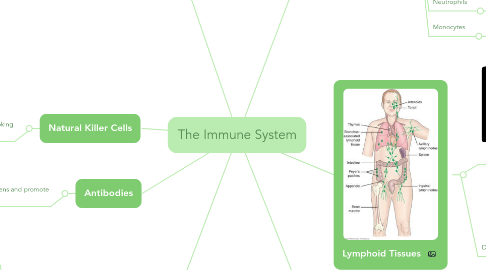
1. Immunoglobulins
1.1. IgG
1.1.1. Most abundant immunoglobulin
1.1.2. Location: Intravascular & intercellular fluid
1.1.3. Neutralized bacterial toxins, accelerates phagocytosis
1.1.4. IgG = Gestational = can be passed from mom to baby
1.2. IgE
1.2.1. Least abundant antibody
1.2.2. Location: Surface of basophils and mast cells
1.2.3. Releases chemicals such as histamines and bradykinin
1.2.4. Allergic, hypersensitivity, and inflammatory reactions
1.3. IgD
1.3.1. Location: Lymphocyte surface
1.3.2. Binds to antigens & promotes secretion of other immunoglobulins
1.4. IgM
1.4.1. Location: Intravascular serum
1.4.2. Agglutinates antigens and lyses cell walls
1.5. IgA
1.5.1. Found in body secretions likes saliva, sweat, tears, mucus, bile, colostrum
1.5.2. IgA = A = Airway! Also in GI tract
1.5.3. Interferes with pathogens at exposed pathways
1.6. G.A.M.E.D.
2. Leukocytes
2.1. Lymphocytes
2.1.1. T Cells
2.1.1.1. Regulatory T Cells
2.1.1.1.1. Hepler T Cells
2.1.1.1.2. Suppressor T Cells
2.1.1.2. Effector T Cells
2.1.1.2.1. Cytotoxic T Cells
2.1.1.3. T cells mature in the thymus
2.1.1.4. Cell-Mediated Response
2.1.2. B Cells
2.1.2.1. Plasma Cells
2.1.2.1.1. Produce Antibodies
2.1.2.1.2. Humoral Response!
2.1.2.2. Memory Cells
2.1.2.2.1. They "remember" antigens and convert into a plasma cell when the antigen is detected
2.1.2.3. B cells mature in the bone marrow
2.2. Neutrophils
2.2.1. Microphage
2.2.1.1. Small cells within the blood that migrate tissue after a cell-mediated response
2.2.1.1.1. Performs phagocytosis
2.3. Monocytes
2.3.1. Macrophage
2.3.1.1. Large cells in tissues & organs
2.3.1.1.1. Performs phagocytosis
3. Lymphoid Tissues
3.1. Lymphatic System
3.1.1. Tonsils & Adenoids
3.1.1.1. Filters bacteria from oral and nasal passages
3.1.2. Spleen
3.1.2.1. Reservoir of blood, removes bacteria & old red blood cells
3.1.3. Lymph Nodes
3.1.3.1. Contains both B and T cells
3.1.3.1.1. Removes bacteria and other particles from the lymph system
3.1.4. Thymus Gland
3.1.4.1. Produces lymphocytes during fetal development
3.1.4.1.1. After birth, this gland "programs" T cells
3.1.5. Bone marrow
3.2. Diagnostics
3.2.1. Lymph node biopsy
3.2.2. Ultrasound of the spleen
3.2.3. Lymphangiography
3.2.4. Radiography
3.2.5. CT
3.2.6. MRI
4. Natural Killer Cells
4.1. Cells that circulate through body looking for infected & cancerous cells
4.1.1. Once identified, NK cells release chemicals that causes cell death to the infected cell
5. Antibodies
5.1. Proteins that bind to antigens and promote destruction of cells
5.1.1. Neutralize toxins
5.1.2. Link antigens together causing agglutination
5.1.3. Cause them to precipitate and become solid
6. Nonantibody Proteins
6.1. Complement System
6.1.1. Chain activation of proteins in response to an antibody binding to an antigen
6.1.1.1. Proteins attack the cell membrane, which causes the destruction of the cell
6.2. Cytokines
6.2.1. Chemical Messengers released by lymphocytes, monocytes, macrophages
6.2.1.1. Interleukins
6.2.1.1.1. Chemical messenger between leukocytes and blood cell producing tissues
6.2.1.2. Interferons
6.2.1.2.1. Protect cells from viral invasion
6.2.1.2.2. Slow viral replication
6.2.1.2.3. Can be utilized for AIDS and some cancers
6.2.1.3. Tumor Necrosis Factor
6.2.1.3.1. Anti-tumor effects
6.2.1.3.2. Helps with cellular repair in small amounts
6.2.1.3.3. Utilized to regulate autoimmune and inflammatory disorders
6.2.1.4. Colony-Stimulating Factors
6.2.1.4.1. Prompt bone marrow to produce and mature blood cells
6.2.1.4.2. epoetin alfa (Epogen), filgrastim (Neupogen), pegfilgrastim (Neulasta), sargramostim (Leukine)
7. Immune System: Innate and Adaptive Immunity Explained
7.1. Immune Crash Course #1
7.1.1. Immune Crash Course #2
7.1.1.1. Immune Crash Course #3
